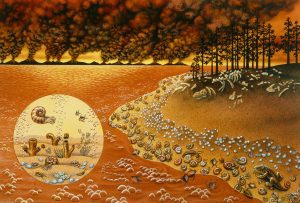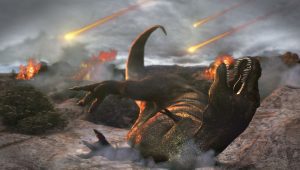AP Biology Unit 7.11: Extinction
Extinctions have shaped Earth’s history, driven by factors such as natural disasters, climate changes, and human activities. They have profoundly influenced the diversity of life by wiping out entire species while creating opportunities for new ones to evolve.

The History of Extinctions
One of the most significant extinction events in Earth’s history is the Permian-Triassic extinction event, also known as the “Great Dying,” which occurred about 252 million years ago. A combination of factors, including massive volcanic eruptions, changes in ocean chemistry, and a dramatic shift in climate, is believed to have caused this event. It is estimated that over 90% of all species on Earth were wiped out as a result of the “Great Dying.” ⚰️

Another significant extinction event is the Cretaceous-Paleogene extinction event, which occurred about 66 million years ago. This event is widely believed to have been caused by the impact of a massive asteroid, resulting in a global firestorm, tsunamis, and a “nuclear winter” effect, ultimately leading to the extinction of dinosaurs and many other species.
Throughout Earth’s history, extinctions have been triggered by natural factors like changes in climate, volcanic eruptions, and sea level changes, as well as human activities like habitat destruction, pollution, and over-exploitation of resources.
Current Extinctions and Ecological Stress
Extinction is an ongoing process that continues today. Many species are currently facing extinction threats due to human activities such as deforestation, pollution, and climate change. The loss of biodiversity can have serious consequences for both the planet and human society, as ecosystems provide crucial services for survival. 😔
Ecological stress can dramatically increase extinction rates, particularly during periods of rapid environmental change. Factors such as changes in climate, pollution, and resource over-exploitation can make it difficult for many species to survive. When ecological stress is severe, the rate of extinction can spike, leading to the rapid loss of numerous species. 🦖
Rate of Speciation vs. Extinction
The level of diversity in an ecosystem depends on both the rate of speciation and the rate of extinction. A high rate of speciation increases diversity, while a high rate of extinction reduces it. The balance between these two rates ultimately determines the net diversity within an ecosystem. ♻️
Extinction may seem frightening, but it is a natural part of life’s cycle. It can be problematic when driven by human activities, but extinction is also necessary for the natural evolution of ecosystems. When a species goes extinct, it often opens up a niche for other species to fill, fostering new opportunities for evolution. Imagine how different our world would be if dinosaurs still roamed Earth, dominating ecosystems! 🍲
New Niches and Adaptive Radiation
A niche refers to the specific role or function that a species plays within an ecosystem. When a species goes extinct, its niche becomes available, allowing other species to evolve and adapt to fill that space. This process is called adaptive radiation, where a lineage diversifies into new forms to adapt to different habitats and ecological roles. Extinction, then, is a key driver of evolutionary opportunities and changes in biodiversity.







